Competitive Strategy: External & Internal Analysis of Aldi
VerifiedAdded on 2021/06/16
|7
|1707
|79
Essay
AI Summary
This essay delves into the application of competitive strategy development tools within organizations to understand their internal and external environments effectively. It introduces the PESTLE and Five Forces analyses for assessing the external environment, focusing on political, economic, social, technological, legal, and environmental factors, as well as competitive forces. The essay also covers SWOT analysis for internal evaluation, highlighting strengths, weaknesses, opportunities, and threats. It emphasizes the importance of these tools in identifying core competencies and gaining a competitive edge, using Aldi as a case study to illustrate their practical application in market analysis and strategic decision-making. The essay concludes with recommendations for utilizing these tools to enhance competitiveness and attract customers.
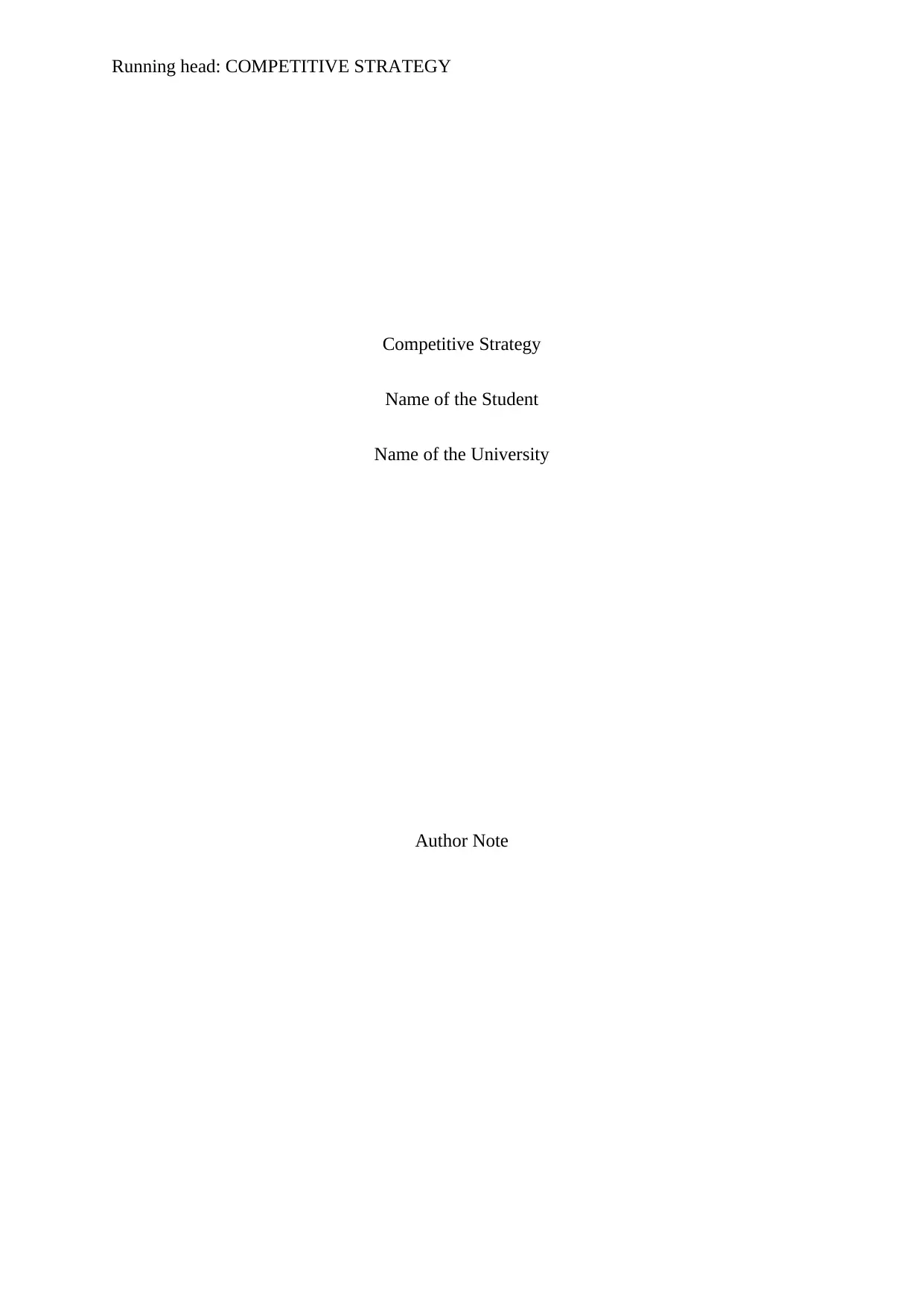
Running head: COMPETITIVE STRATEGY
Competitive Strategy
Name of the Student
Name of the University
Author Note
Competitive Strategy
Name of the Student
Name of the University
Author Note
Paraphrase This Document
Need a fresh take? Get an instant paraphrase of this document with our AI Paraphraser
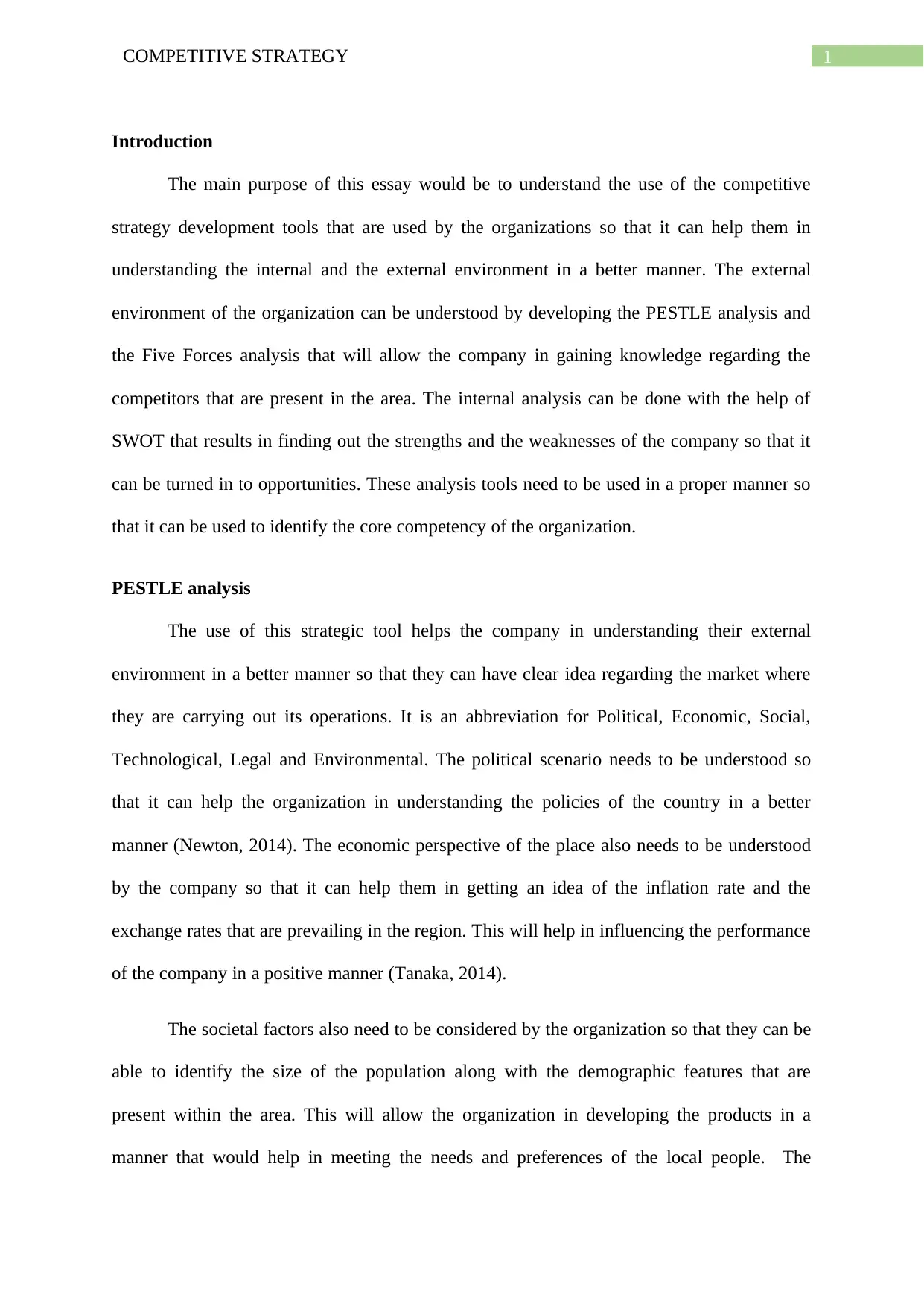
1COMPETITIVE STRATEGY
Introduction
The main purpose of this essay would be to understand the use of the competitive
strategy development tools that are used by the organizations so that it can help them in
understanding the internal and the external environment in a better manner. The external
environment of the organization can be understood by developing the PESTLE analysis and
the Five Forces analysis that will allow the company in gaining knowledge regarding the
competitors that are present in the area. The internal analysis can be done with the help of
SWOT that results in finding out the strengths and the weaknesses of the company so that it
can be turned in to opportunities. These analysis tools need to be used in a proper manner so
that it can be used to identify the core competency of the organization.
PESTLE analysis
The use of this strategic tool helps the company in understanding their external
environment in a better manner so that they can have clear idea regarding the market where
they are carrying out its operations. It is an abbreviation for Political, Economic, Social,
Technological, Legal and Environmental. The political scenario needs to be understood so
that it can help the organization in understanding the policies of the country in a better
manner (Newton, 2014). The economic perspective of the place also needs to be understood
by the company so that it can help them in getting an idea of the inflation rate and the
exchange rates that are prevailing in the region. This will help in influencing the performance
of the company in a positive manner (Tanaka, 2014).
The societal factors also need to be considered by the organization so that they can be
able to identify the size of the population along with the demographic features that are
present within the area. This will allow the organization in developing the products in a
manner that would help in meeting the needs and preferences of the local people. The
Introduction
The main purpose of this essay would be to understand the use of the competitive
strategy development tools that are used by the organizations so that it can help them in
understanding the internal and the external environment in a better manner. The external
environment of the organization can be understood by developing the PESTLE analysis and
the Five Forces analysis that will allow the company in gaining knowledge regarding the
competitors that are present in the area. The internal analysis can be done with the help of
SWOT that results in finding out the strengths and the weaknesses of the company so that it
can be turned in to opportunities. These analysis tools need to be used in a proper manner so
that it can be used to identify the core competency of the organization.
PESTLE analysis
The use of this strategic tool helps the company in understanding their external
environment in a better manner so that they can have clear idea regarding the market where
they are carrying out its operations. It is an abbreviation for Political, Economic, Social,
Technological, Legal and Environmental. The political scenario needs to be understood so
that it can help the organization in understanding the policies of the country in a better
manner (Newton, 2014). The economic perspective of the place also needs to be understood
by the company so that it can help them in getting an idea of the inflation rate and the
exchange rates that are prevailing in the region. This will help in influencing the performance
of the company in a positive manner (Tanaka, 2014).
The societal factors also need to be considered by the organization so that they can be
able to identify the size of the population along with the demographic features that are
present within the area. This will allow the organization in developing the products in a
manner that would help in meeting the needs and preferences of the local people. The
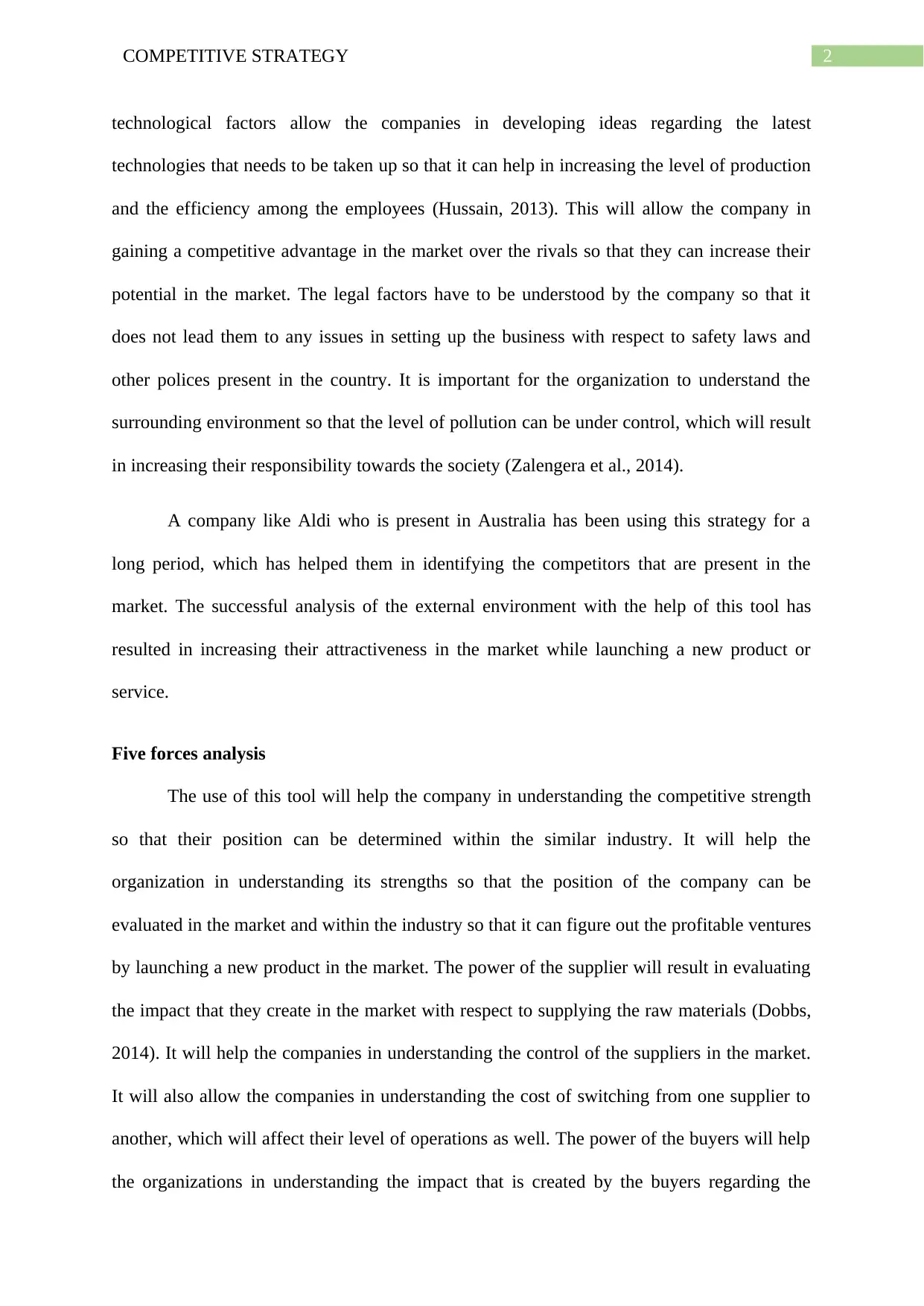
2COMPETITIVE STRATEGY
technological factors allow the companies in developing ideas regarding the latest
technologies that needs to be taken up so that it can help in increasing the level of production
and the efficiency among the employees (Hussain, 2013). This will allow the company in
gaining a competitive advantage in the market over the rivals so that they can increase their
potential in the market. The legal factors have to be understood by the company so that it
does not lead them to any issues in setting up the business with respect to safety laws and
other polices present in the country. It is important for the organization to understand the
surrounding environment so that the level of pollution can be under control, which will result
in increasing their responsibility towards the society (Zalengera et al., 2014).
A company like Aldi who is present in Australia has been using this strategy for a
long period, which has helped them in identifying the competitors that are present in the
market. The successful analysis of the external environment with the help of this tool has
resulted in increasing their attractiveness in the market while launching a new product or
service.
Five forces analysis
The use of this tool will help the company in understanding the competitive strength
so that their position can be determined within the similar industry. It will help the
organization in understanding its strengths so that the position of the company can be
evaluated in the market and within the industry so that it can figure out the profitable ventures
by launching a new product in the market. The power of the supplier will result in evaluating
the impact that they create in the market with respect to supplying the raw materials (Dobbs,
2014). It will help the companies in understanding the control of the suppliers in the market.
It will also allow the companies in understanding the cost of switching from one supplier to
another, which will affect their level of operations as well. The power of the buyers will help
the organizations in understanding the impact that is created by the buyers regarding the
technological factors allow the companies in developing ideas regarding the latest
technologies that needs to be taken up so that it can help in increasing the level of production
and the efficiency among the employees (Hussain, 2013). This will allow the company in
gaining a competitive advantage in the market over the rivals so that they can increase their
potential in the market. The legal factors have to be understood by the company so that it
does not lead them to any issues in setting up the business with respect to safety laws and
other polices present in the country. It is important for the organization to understand the
surrounding environment so that the level of pollution can be under control, which will result
in increasing their responsibility towards the society (Zalengera et al., 2014).
A company like Aldi who is present in Australia has been using this strategy for a
long period, which has helped them in identifying the competitors that are present in the
market. The successful analysis of the external environment with the help of this tool has
resulted in increasing their attractiveness in the market while launching a new product or
service.
Five forces analysis
The use of this tool will help the company in understanding the competitive strength
so that their position can be determined within the similar industry. It will help the
organization in understanding its strengths so that the position of the company can be
evaluated in the market and within the industry so that it can figure out the profitable ventures
by launching a new product in the market. The power of the supplier will result in evaluating
the impact that they create in the market with respect to supplying the raw materials (Dobbs,
2014). It will help the companies in understanding the control of the suppliers in the market.
It will also allow the companies in understanding the cost of switching from one supplier to
another, which will affect their level of operations as well. The power of the buyers will help
the organizations in understanding the impact that is created by the buyers regarding the
⊘ This is a preview!⊘
Do you want full access?
Subscribe today to unlock all pages.

Trusted by 1+ million students worldwide
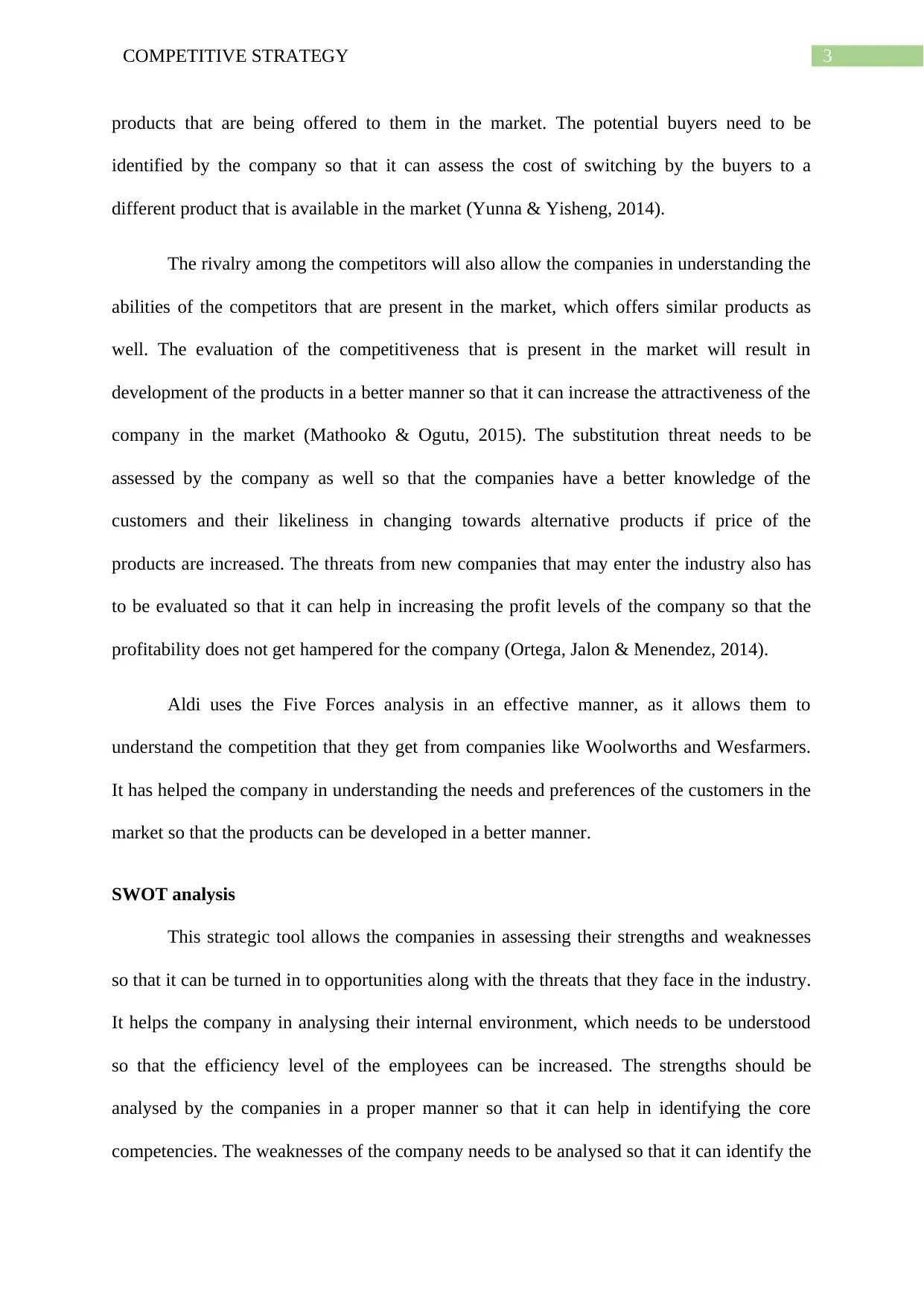
3COMPETITIVE STRATEGY
products that are being offered to them in the market. The potential buyers need to be
identified by the company so that it can assess the cost of switching by the buyers to a
different product that is available in the market (Yunna & Yisheng, 2014).
The rivalry among the competitors will also allow the companies in understanding the
abilities of the competitors that are present in the market, which offers similar products as
well. The evaluation of the competitiveness that is present in the market will result in
development of the products in a better manner so that it can increase the attractiveness of the
company in the market (Mathooko & Ogutu, 2015). The substitution threat needs to be
assessed by the company as well so that the companies have a better knowledge of the
customers and their likeliness in changing towards alternative products if price of the
products are increased. The threats from new companies that may enter the industry also has
to be evaluated so that it can help in increasing the profit levels of the company so that the
profitability does not get hampered for the company (Ortega, Jalon & Menendez, 2014).
Aldi uses the Five Forces analysis in an effective manner, as it allows them to
understand the competition that they get from companies like Woolworths and Wesfarmers.
It has helped the company in understanding the needs and preferences of the customers in the
market so that the products can be developed in a better manner.
SWOT analysis
This strategic tool allows the companies in assessing their strengths and weaknesses
so that it can be turned in to opportunities along with the threats that they face in the industry.
It helps the company in analysing their internal environment, which needs to be understood
so that the efficiency level of the employees can be increased. The strengths should be
analysed by the companies in a proper manner so that it can help in identifying the core
competencies. The weaknesses of the company needs to be analysed so that it can identify the
products that are being offered to them in the market. The potential buyers need to be
identified by the company so that it can assess the cost of switching by the buyers to a
different product that is available in the market (Yunna & Yisheng, 2014).
The rivalry among the competitors will also allow the companies in understanding the
abilities of the competitors that are present in the market, which offers similar products as
well. The evaluation of the competitiveness that is present in the market will result in
development of the products in a better manner so that it can increase the attractiveness of the
company in the market (Mathooko & Ogutu, 2015). The substitution threat needs to be
assessed by the company as well so that the companies have a better knowledge of the
customers and their likeliness in changing towards alternative products if price of the
products are increased. The threats from new companies that may enter the industry also has
to be evaluated so that it can help in increasing the profit levels of the company so that the
profitability does not get hampered for the company (Ortega, Jalon & Menendez, 2014).
Aldi uses the Five Forces analysis in an effective manner, as it allows them to
understand the competition that they get from companies like Woolworths and Wesfarmers.
It has helped the company in understanding the needs and preferences of the customers in the
market so that the products can be developed in a better manner.
SWOT analysis
This strategic tool allows the companies in assessing their strengths and weaknesses
so that it can be turned in to opportunities along with the threats that they face in the industry.
It helps the company in analysing their internal environment, which needs to be understood
so that the efficiency level of the employees can be increased. The strengths should be
analysed by the companies in a proper manner so that it can help in identifying the core
competencies. The weaknesses of the company needs to be analysed so that it can identify the
Paraphrase This Document
Need a fresh take? Get an instant paraphrase of this document with our AI Paraphraser
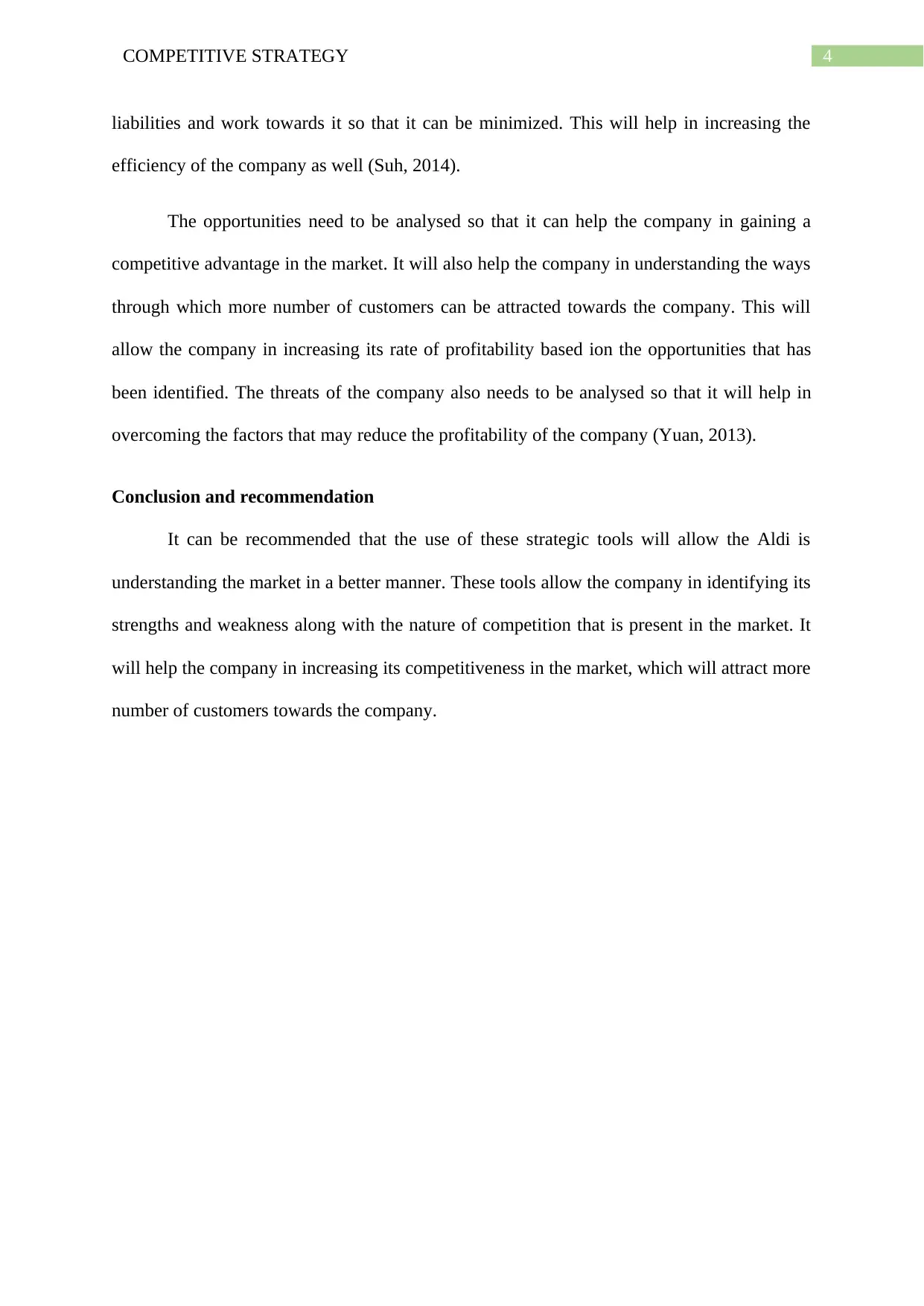
4COMPETITIVE STRATEGY
liabilities and work towards it so that it can be minimized. This will help in increasing the
efficiency of the company as well (Suh, 2014).
The opportunities need to be analysed so that it can help the company in gaining a
competitive advantage in the market. It will also help the company in understanding the ways
through which more number of customers can be attracted towards the company. This will
allow the company in increasing its rate of profitability based ion the opportunities that has
been identified. The threats of the company also needs to be analysed so that it will help in
overcoming the factors that may reduce the profitability of the company (Yuan, 2013).
Conclusion and recommendation
It can be recommended that the use of these strategic tools will allow the Aldi is
understanding the market in a better manner. These tools allow the company in identifying its
strengths and weakness along with the nature of competition that is present in the market. It
will help the company in increasing its competitiveness in the market, which will attract more
number of customers towards the company.
liabilities and work towards it so that it can be minimized. This will help in increasing the
efficiency of the company as well (Suh, 2014).
The opportunities need to be analysed so that it can help the company in gaining a
competitive advantage in the market. It will also help the company in understanding the ways
through which more number of customers can be attracted towards the company. This will
allow the company in increasing its rate of profitability based ion the opportunities that has
been identified. The threats of the company also needs to be analysed so that it will help in
overcoming the factors that may reduce the profitability of the company (Yuan, 2013).
Conclusion and recommendation
It can be recommended that the use of these strategic tools will allow the Aldi is
understanding the market in a better manner. These tools allow the company in identifying its
strengths and weakness along with the nature of competition that is present in the market. It
will help the company in increasing its competitiveness in the market, which will attract more
number of customers towards the company.
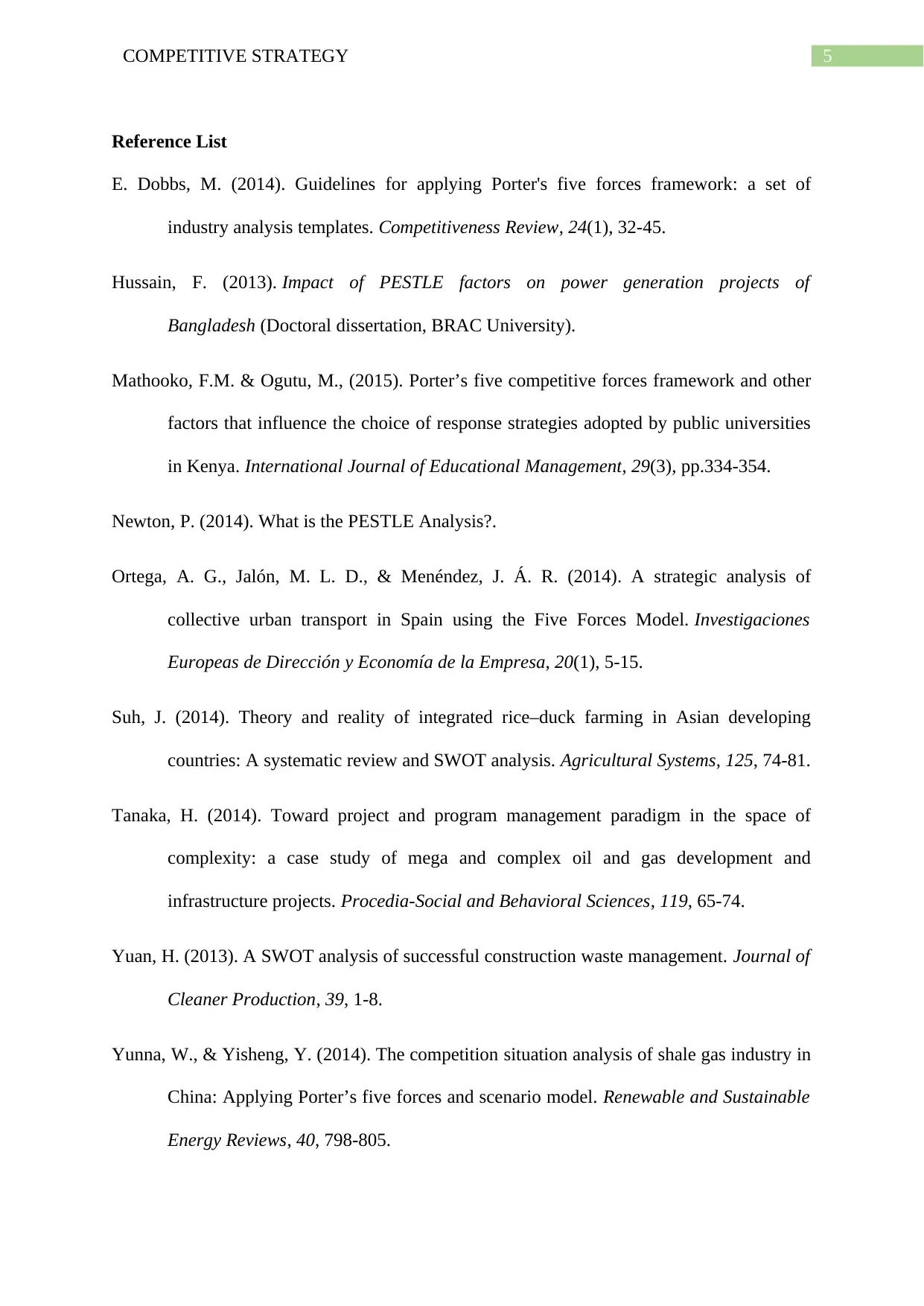
5COMPETITIVE STRATEGY
Reference List
E. Dobbs, M. (2014). Guidelines for applying Porter's five forces framework: a set of
industry analysis templates. Competitiveness Review, 24(1), 32-45.
Hussain, F. (2013). Impact of PESTLE factors on power generation projects of
Bangladesh (Doctoral dissertation, BRAC University).
Mathooko, F.M. & Ogutu, M., (2015). Porter’s five competitive forces framework and other
factors that influence the choice of response strategies adopted by public universities
in Kenya. International Journal of Educational Management, 29(3), pp.334-354.
Newton, P. (2014). What is the PESTLE Analysis?.
Ortega, A. G., Jalón, M. L. D., & Menéndez, J. Á. R. (2014). A strategic analysis of
collective urban transport in Spain using the Five Forces Model. Investigaciones
Europeas de Dirección y Economía de la Empresa, 20(1), 5-15.
Suh, J. (2014). Theory and reality of integrated rice–duck farming in Asian developing
countries: A systematic review and SWOT analysis. Agricultural Systems, 125, 74-81.
Tanaka, H. (2014). Toward project and program management paradigm in the space of
complexity: a case study of mega and complex oil and gas development and
infrastructure projects. Procedia-Social and Behavioral Sciences, 119, 65-74.
Yuan, H. (2013). A SWOT analysis of successful construction waste management. Journal of
Cleaner Production, 39, 1-8.
Yunna, W., & Yisheng, Y. (2014). The competition situation analysis of shale gas industry in
China: Applying Porter’s five forces and scenario model. Renewable and Sustainable
Energy Reviews, 40, 798-805.
Reference List
E. Dobbs, M. (2014). Guidelines for applying Porter's five forces framework: a set of
industry analysis templates. Competitiveness Review, 24(1), 32-45.
Hussain, F. (2013). Impact of PESTLE factors on power generation projects of
Bangladesh (Doctoral dissertation, BRAC University).
Mathooko, F.M. & Ogutu, M., (2015). Porter’s five competitive forces framework and other
factors that influence the choice of response strategies adopted by public universities
in Kenya. International Journal of Educational Management, 29(3), pp.334-354.
Newton, P. (2014). What is the PESTLE Analysis?.
Ortega, A. G., Jalón, M. L. D., & Menéndez, J. Á. R. (2014). A strategic analysis of
collective urban transport in Spain using the Five Forces Model. Investigaciones
Europeas de Dirección y Economía de la Empresa, 20(1), 5-15.
Suh, J. (2014). Theory and reality of integrated rice–duck farming in Asian developing
countries: A systematic review and SWOT analysis. Agricultural Systems, 125, 74-81.
Tanaka, H. (2014). Toward project and program management paradigm in the space of
complexity: a case study of mega and complex oil and gas development and
infrastructure projects. Procedia-Social and Behavioral Sciences, 119, 65-74.
Yuan, H. (2013). A SWOT analysis of successful construction waste management. Journal of
Cleaner Production, 39, 1-8.
Yunna, W., & Yisheng, Y. (2014). The competition situation analysis of shale gas industry in
China: Applying Porter’s five forces and scenario model. Renewable and Sustainable
Energy Reviews, 40, 798-805.
⊘ This is a preview!⊘
Do you want full access?
Subscribe today to unlock all pages.

Trusted by 1+ million students worldwide
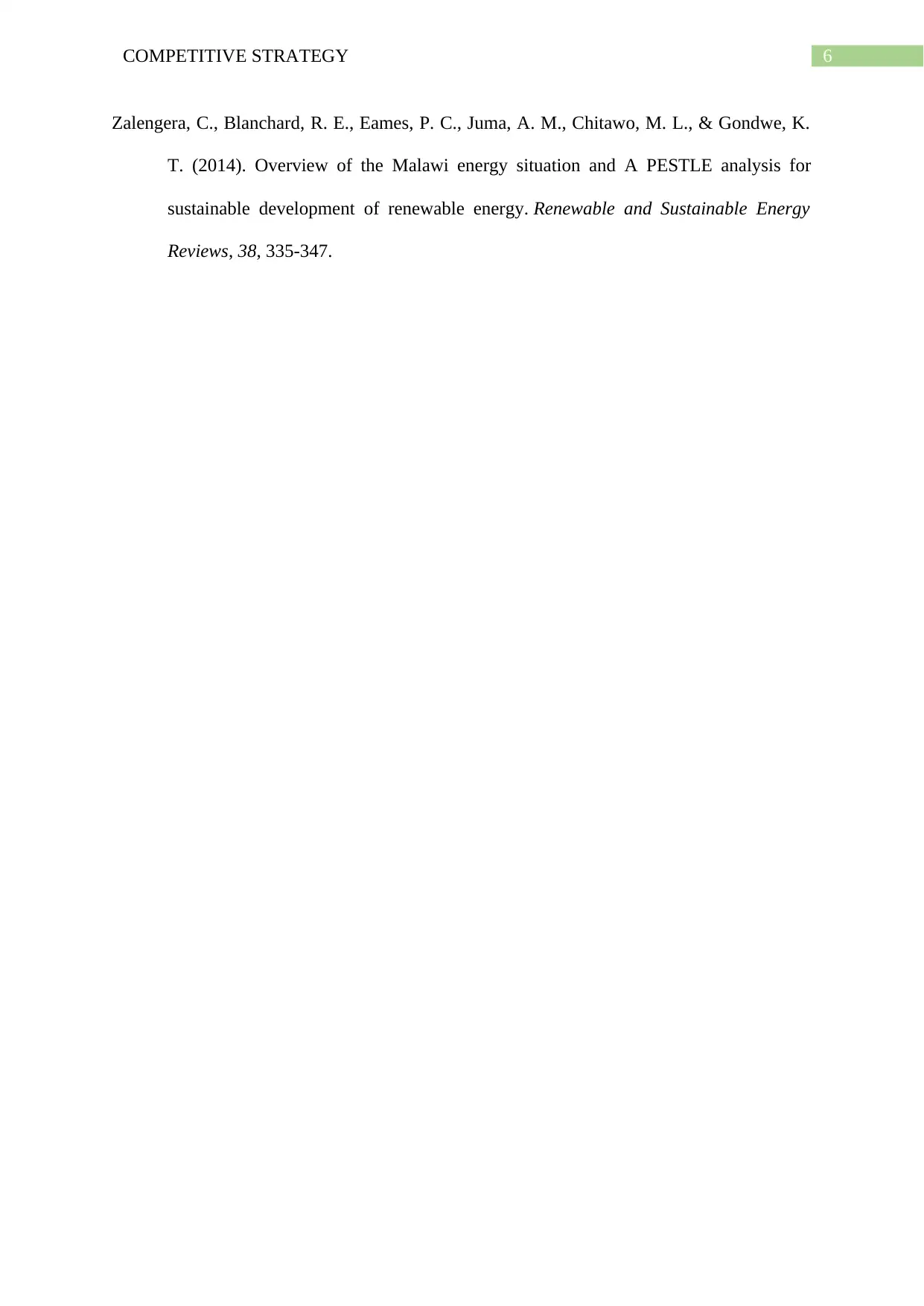
6COMPETITIVE STRATEGY
Zalengera, C., Blanchard, R. E., Eames, P. C., Juma, A. M., Chitawo, M. L., & Gondwe, K.
T. (2014). Overview of the Malawi energy situation and A PESTLE analysis for
sustainable development of renewable energy. Renewable and Sustainable Energy
Reviews, 38, 335-347.
Zalengera, C., Blanchard, R. E., Eames, P. C., Juma, A. M., Chitawo, M. L., & Gondwe, K.
T. (2014). Overview of the Malawi energy situation and A PESTLE analysis for
sustainable development of renewable energy. Renewable and Sustainable Energy
Reviews, 38, 335-347.
1 out of 7
Related Documents
Your All-in-One AI-Powered Toolkit for Academic Success.
+13062052269
info@desklib.com
Available 24*7 on WhatsApp / Email
![[object Object]](/_next/static/media/star-bottom.7253800d.svg)
Unlock your academic potential
Copyright © 2020–2025 A2Z Services. All Rights Reserved. Developed and managed by ZUCOL.




